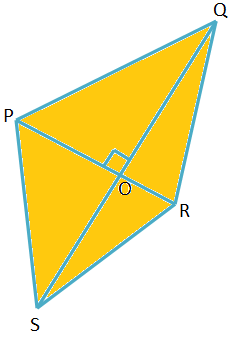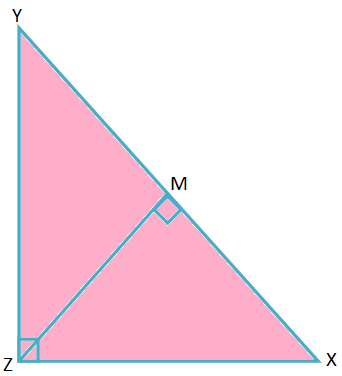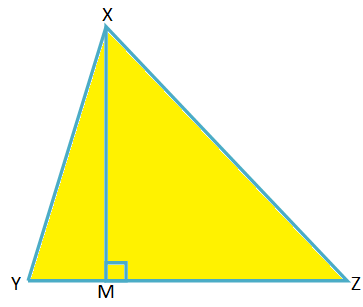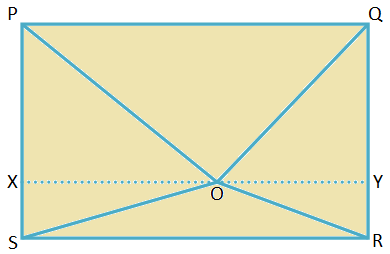Subscribe to our ▶️ YouTube channel 🔴 for the latest videos, updates, and tips.
Riders Based on Pythagoras’ Theorem
Here we will solve different types of examples on establishing riders based on Pythagoras’ theorem.
1. In the quadrilateral PQRS the diagonals PR and QS intersects at a right angle. Prove that PQ2+ RS2 = PS2 + QR2.
Solution:
Let the diagonals intersect at O, the angle of intersection being a right angle.
In the right-angle ∆POQ, PQ2 = OP2 + OQ2.
In the right-angle ∆ROS, RS2 = OR2 + OS2.
Therefore, PQ2 + RS2 = OP2 + OQ2 + OR2 + OS2 ................. (i)
In the right-angle ∆POS, PS2 = OP2 + OS2.
In the right-angle ∆QOR, QR2 = OQ2 + OR2.
Therefore, PS2 + QR2 = OP2 + OS2 + OQ2 + OR2 ................. (ii)
From (i) and (ii), PQ2+ RS2 = PS2 + QR2. (Proved).
2. In ∆XYZ, ∠Z = 90° and ZM ⊥ XY, where M is the foot of the perpendicular. Prove that \(\frac{1}{ZM^{2}}\) = \(\frac{1}{YZ^{2}}\) + \(\frac{1}{XZ^{2}}\).
Solution:
In ∆XYZ and ∆ZYM,
∠XZY = ∠ZMY = 90°,
∠XYZ = ∠ZYM (Common Angle)
Therefore, by AA criterion of similarity, ∆XYZ ∼ ∆ZYM.
\(\frac{XY}{YZ}\) = \(\frac{XZ}{ZM}\)
⟹ YZ ∙ XZ = XY ∙ ZM
Therefore, ZM = \(\frac{YZ ∙ XZ}{XY}\)
Therefore, \(\frac{1}{ZM^{2}}\) = \(\frac{XY^{2}}{YZ^{2} ∙ XZ^{2}}\) = \(\frac{XZ^{2} + YZ^{2}}{YZ^{2} ∙ XZ^{2}}\); [By Pythagoras’ theorem)
Therefore, \(\frac{1}{ZM^{2}}\) = \(\frac{1}{YZ^{2}}\) + \(\frac{1}{XZ^{2}}\). (Proved)
3. In ∆XYZ, ∠Z is acute and XM ⊥ YZ, M being the foot of the perpendicular. Prove that 2YZ ∙ ZM = YZ2 + ZX2 - XY2.
Solution:
From the right-angled ∆XMY,
XY2 = XM2 + YM2
= XM2 + (YZ - ZM)2
= XM2 + YZ2 + ZM2 - 2YZ ∙ ZM (from algebra)
= YZ2 - 2YZ ∙ ZM + (XM2 + ZM2)
= YZ2 - 2YZ ∙ ZM + XZ2 (from right-angled ∆XMZ)
Therefore, 2YZ ∙ ZM = YZ2 + ZX2 – XY2. (Proved)
4. Let PQRS be a rectangle. O is a point inside the rectangle. Prove that OP2 + OR2 = OQ2 + OS2.
Solution:
PQRS is a rectangle for which PQ = SR = length and QR = PS = breadth.
Join OP, OQ, OR and OS.
Draw XY through O, parallel to PQ.
As ∠QPS and ∠RSP are right angles, ∆PXO, ∆SXO, ∆RYO and ∆QYO are right-angled triangles.
Therefore, by Pythagoras’ theorem,
OP2 = PX2 + OX2,
OR2 = RY2 + OY2,
OQ2 = QY2 + OY2 and
OS2 = SX2 + OX2
Therefore, OP2 + OR2 = PX2 + OX2 + RY2 + OY2 ......... (i)
OQ2 + OS2 = QY2 + OY2 + SX2 + OX2 ......... (ii)
But in the rectangle XSRY, SX = RY = breadth
and in the rectangle PXYQ, PX = QY = breadth.
Therefore, from (i) and (ii), OP2 + OR2 = OQ2 + OS2.
From Riders Based on Pythagoras’ Theorem to HOME PAGE
Didn't find what you were looking for? Or want to know more information about Math Only Math. Use this Google Search to find what you need.






New! Comments
Have your say about what you just read! Leave me a comment in the box below. Ask a Question or Answer a Question.